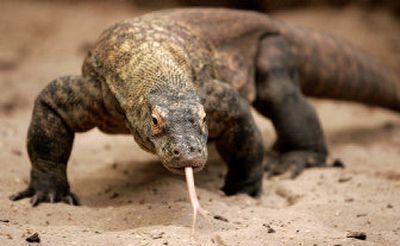Virgin Komodo dragon soon to become mother

CHESTER, England – As Christmas approaches, a virgin mother is anxiously awaiting the arrival of her offspring. She’s Flora, the Komodo dragon.
In an evolutionary twist, Flora has managed to become pregnant without any male help. It would seem the timing is auspicious: The seven baby Komodo dragons are due this festive season.
“We were blown away when we realized what she’d done,” said Kevin Buley, a reptile expert at Flora’s home at the Chester Zoo in this town in northern England. “But we certainly won’t be naming any of the hatchlings Jesus.”
Other reptile species reproduce asexually in a process known as parthenogenesis. But Flora’s virginal conception, and that of another Komodo dragon earlier this year at the London Zoo, are the first time it has been documented in a Komodo dragon.
The reptiles, renowned for their intelligence, are native to Indonesia. They are the world’s largest lizards and have no natural predators – making them on par with sharks and lions at the pinnacle of the animal kingdom.
The cases of Flora and the London lizard, Sungai, are described in a paper published today in the journal Nature.
Parthenogenesis is a process in which eggs become embryos without male fertilization. It has been seen in about 70 species, including snakes and lizards. Scientists are unsure whether female Komodo dragons have always had this latent ability to reproduce or if this is an evolutionary development.
At 8 years old, Flora – whom Buley describes as “demure” – is sexually mature. Having been raised in captivity, she has never been exposed to a male Komodo dragon. She lives with her younger sister, Nessie.
Flora’s keepers first became suspicious in May, when she laid 25 eggs.
Though it’s not uncommon for female dragons to lay eggs without mating, such eggs are not usually fertilized. As a precaution, they were placed in an incubator. About half of Flora’s eggs looked like real eggs – they were very white and had solid shells.
When three of them collapsed, scientists took a closer look.
“We saw blood vessels and a small embryo,” said Buley, one of the Nature study’s authors. “And we knew immediately that Flora had fertilized the eggs herself.”
They then sent the collapsed eggs, along with tissue samples from Flora, Nessie, and a male Komodo dragon, to a laboratory in nearby Liverpool that conducted genetic testing to determine the eggs’ parentage. Results showed that although the baby Komodo dragons are not exact Flora clones, their DNA could not have come from any other dragon.
At the London Zoo, Sungai became mother to four dragon hatchlings in April through self-fertilization. After their births, Sungai went on to mate normally with a male dragon, producing another baby dragon.
“Komodo dragons seem to be able to switch ways of reproducing to deal with a shortage of suitable boyfriends,” said Dr. Rick Shine, a professor of evolutionary biology at the University of Sydney, Australia. Shine was not involved with the Nature paper. In contrast, other lizard species that reproduce asexually cannot mate normally.